|
Awaking
the next morning we were raring to go. First stop: McDonald's for
a junk-food breakfast. One thing about Singapore is that it is up
on all the junk food joints. No problem finding whatever you want
in Singapore. Our destination this morning: Arab Street.
If
you haven't guessed by now Singapore is a city for shopping. From
what we gathered many of the tourists are drawn to Singapore because
of the excellent shopping that can be found everywhere. Orchard
Street has all the fashionable shops, including all the designer
names, and department stores. For the more adventurous you can wander
around Singapore's Chinatown, Arab Street and Little India districts.
Each has its own flavor and its own special items of interest. Anne
and I, however, were not in Singapore to shop. We were there to
enjoy the flavor and excitement of the city.
|
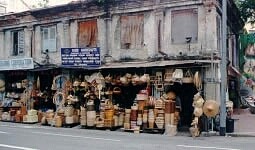
Baskets
were bargains on Arab Street
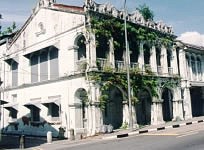
Arab
Street
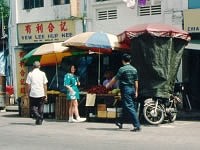
Anne
checking a street
vendors offerings
|
|
|
|
|
|
|
|
|
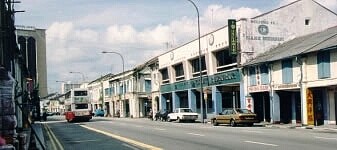 Arab
Street
Arab
Street |
|
|
|
|
|
|
|
|
|
|
| While
we were not there to shop we did enjoy the browsing. It's amazing
what you can find in some of these places and Arab Street was no exception.
There were many interesting articles, especially antiques, that kept
us busy for quite some time, but not the entire day. |
|
|
|
|
|
|
|
|
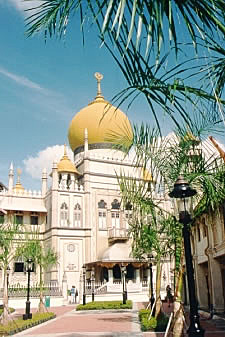 Masjid
Sultan
Masjid
Sultan |
|
|
|
|
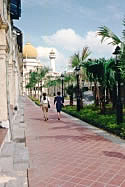
The main walkway
to the
Masjid Sultan |
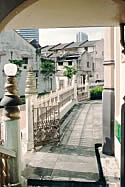 An
interesting
An
interesting
walkway on the side
of the Mosque |
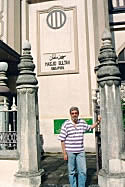 Yours
truly standing
Yours
truly standing
at the entrance to
the Mosque |
|
|
|
|
|
|
|
|
|
|
|
|
|
|
|
|
|
|
The
building (immediate right) was located next to the Sultan Mosque.
I am not sure as to its function or significance, but it was an interesting
building because of its color.
The minaret of the Haijah Fatimah Mosque (far right) is said
to have been modeled after the spire of the original St. Andrew's
Cathedral. For some unknown reason the minaret is built so that it
leans at a 6-degree angle. |
|
|
|
|
|
|
|
|
|
|
|
|
|
|
|
Singapore's
Little India district is a fascinating place to visit. As you
can see by these two photos they streets were jammed with the wares
the vendors were selling which included brightly colored clothes.
Little India is also known for its gold. Anne and I browsed a number
of the shops.
|
|
|
|
|
|
|
|
|
|
|
|
|
|
|
The
most fascinating thing about Little India was the food. Food vendors
were everywhere and the smells were absolutely fantastic. Anne and
I soon found ourselves hungry and searching for a place to eat.
Many places the food looked great, but the services, well, they
left something to be desired. The food was served "au natural."
By that I mean on banana leaves with no eating utensils, no fork,
no spoon and no knife. We passed and looked for a more conventional
restaurant which we soon found.
I
have to admit I learned something during this meal. Anne and I have
always been fond of Indian food and have gone to a number of Indian
restaurants in the U. S., England and some of the islands. But this
is the first time we'd ever been to an Indian restaurant as authentic
as these were. We sat back and enjoyed the air conditioning while
waiting for our food. An Indian gentleman dressed in a western style
suit came in and sat at the table next to us. Watching him eat was
an experience. He ate without utensils using the naan bread to scoop
up his food. When he finished his plate was as clean as a whistle
almost as if it had been washed. You could tell by watching him
that he thoroughly enjoyed the food. When he finished a quick dip
of his fingers into his water glass and he was ready to run off.
I've never seen anyone eat this way before and it was interesting
to watch (without trying to be conspicuous that I was watching!).
|
|
|
|
|
|
|
|
|
|
|
|
|
Leaving
Little India we saw another interesting Hindu temple with an elaborate
gopuram. (Believed to be the) Sri Veeramakaliamman Temple was
built in 1881 and is dedicated to Kali the Courageous, a ferocious
incarnation of Shiva's wife, Parvati the Beautiful. It's hard to see,
but on the right side of the building are located several Coke machines
which totally ruin the view of this temple.
Leaving Little India Anne and I headed toward Colonial Singapore and
the Raffles Hotel. |
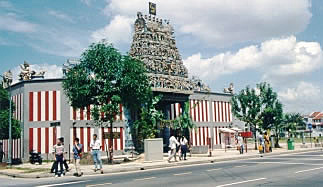 Sri
Veeramakaliamman Temple
Sri
Veeramakaliamman Temple |
|
|
|
|
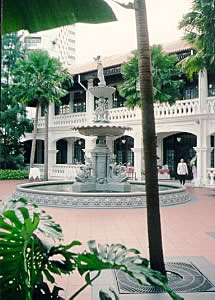 Fountain
at the Raffles Hotel
Fountain
at the Raffles Hotel |
|
|
|
|
|
|
|
|
|
|
|
|
|
|
|
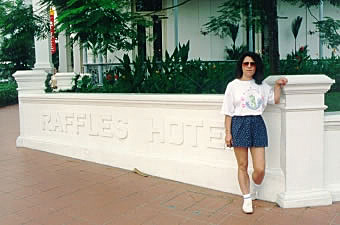 Anne
standing by the entrance to the Raffles Hotel
Anne
standing by the entrance to the Raffles Hotel |
|
|
|
|
|
|
|
|
|
|
|
|
|
|
| The
Raffles Hotel has a long history especially during World War
II. It was, at first, a center for British refugees, then Japanese
officer's quarters, and, finally, a center for released Allied prisoners.
After the war the hotel deteriorated and survived mostly as a tourist
site. In 1991 the hotel was reopened following extensive repairs and
upgrades. Today it is Singapore's most expensive hotel. It was here
at Raffles Hotel's Long Bar that the Singapore Sling was first created.
Walking through its lobby it is much like any other luxury hotel today,
full of shops and high-priced articles. |
|
|
|
|
|
|
|
|
|
|
|
|





